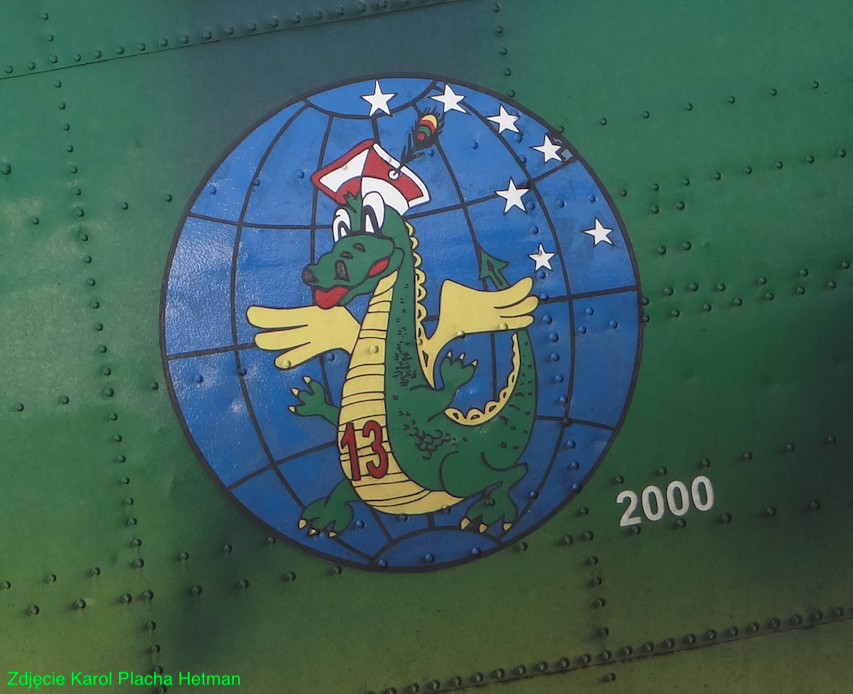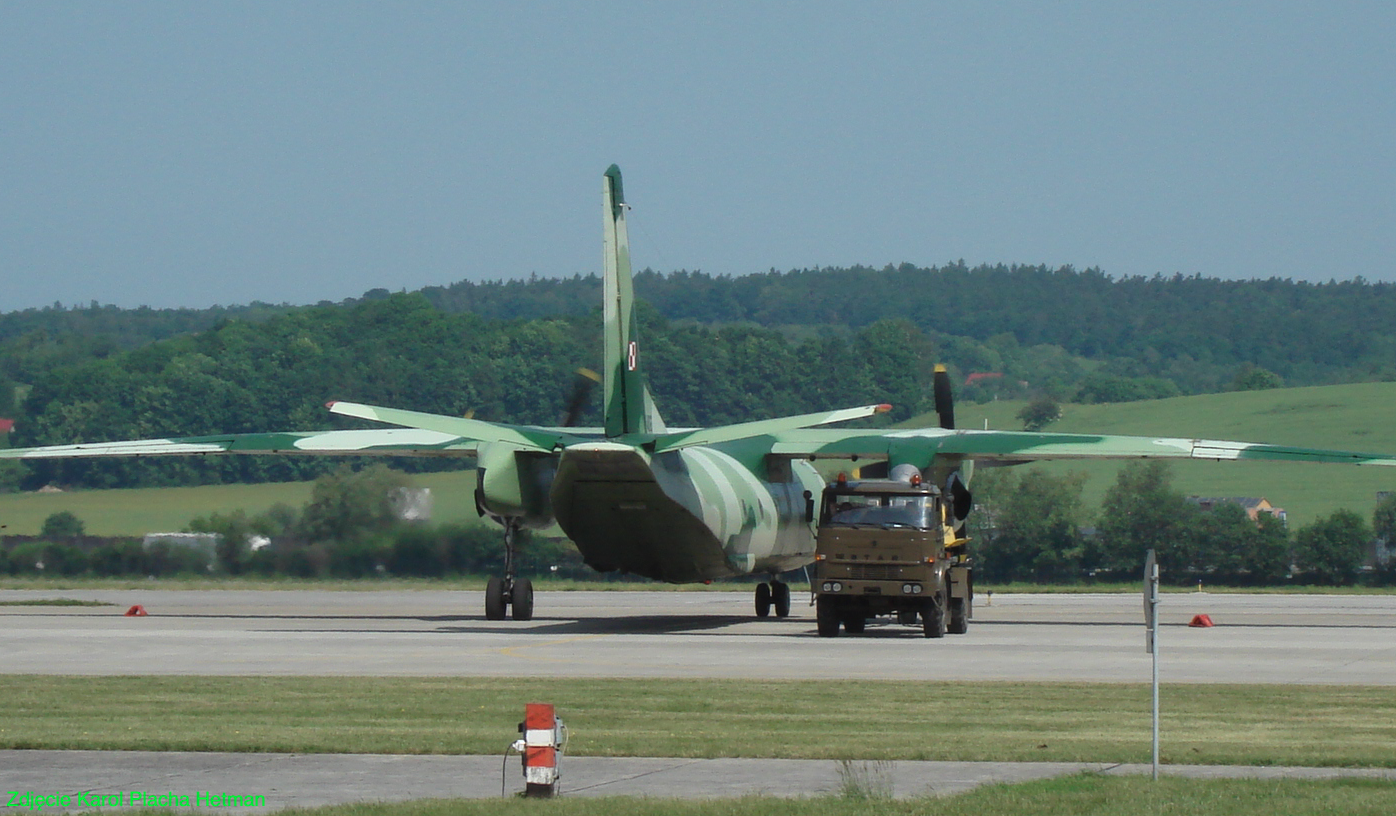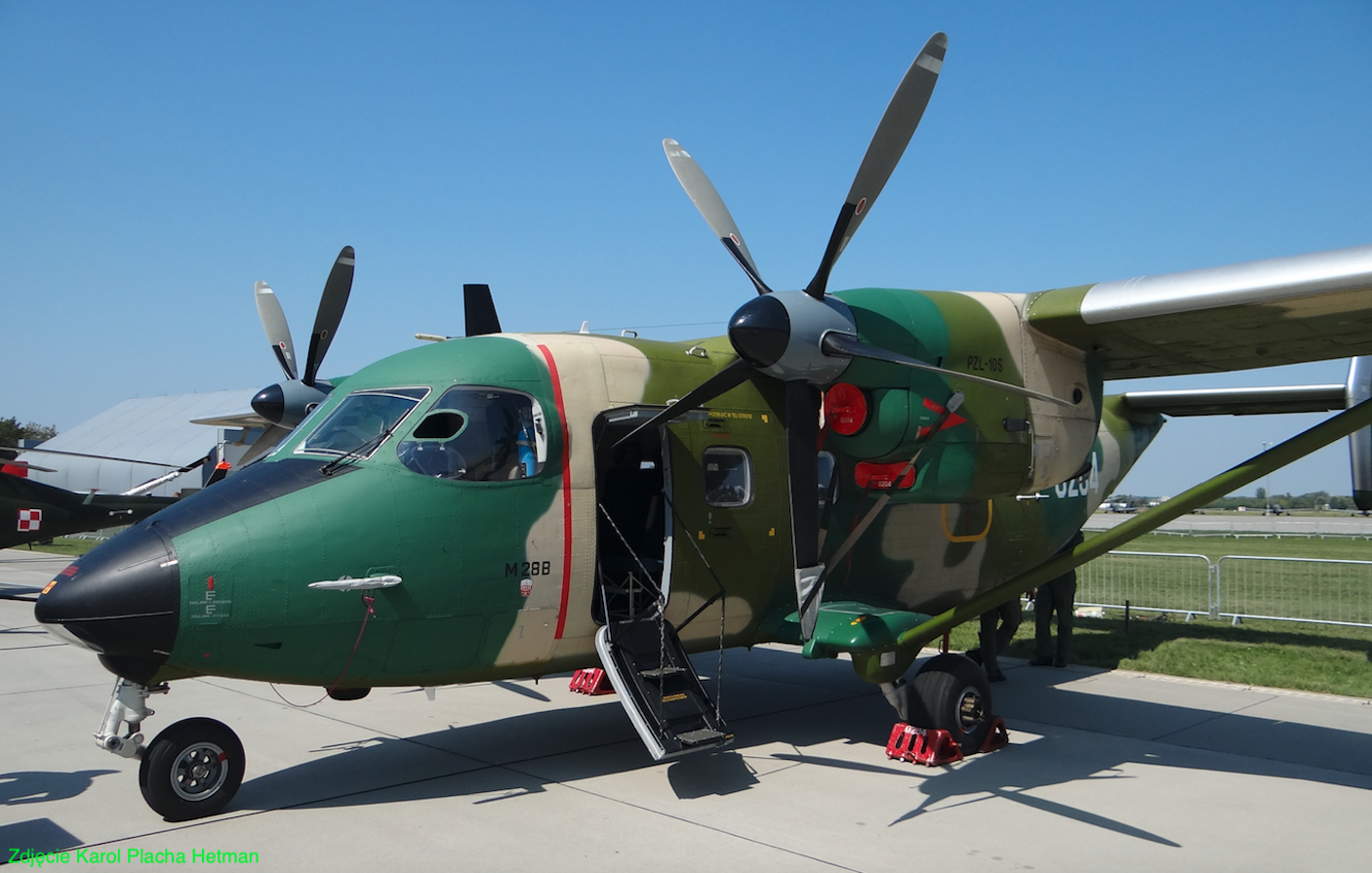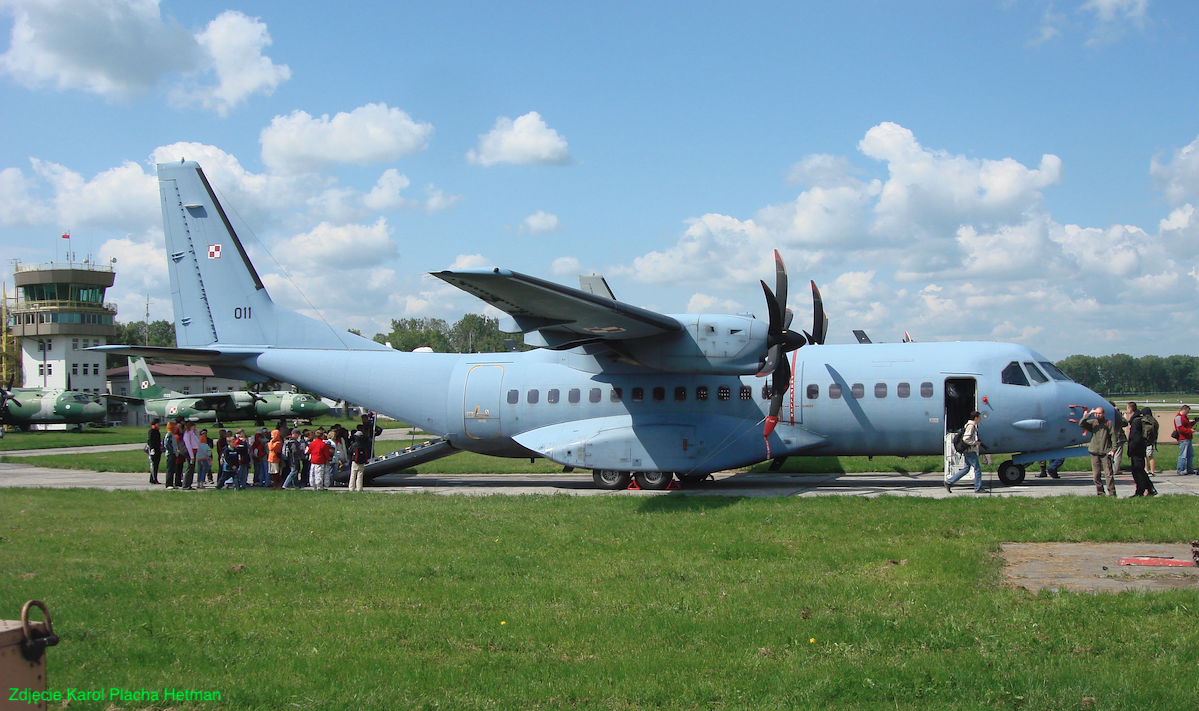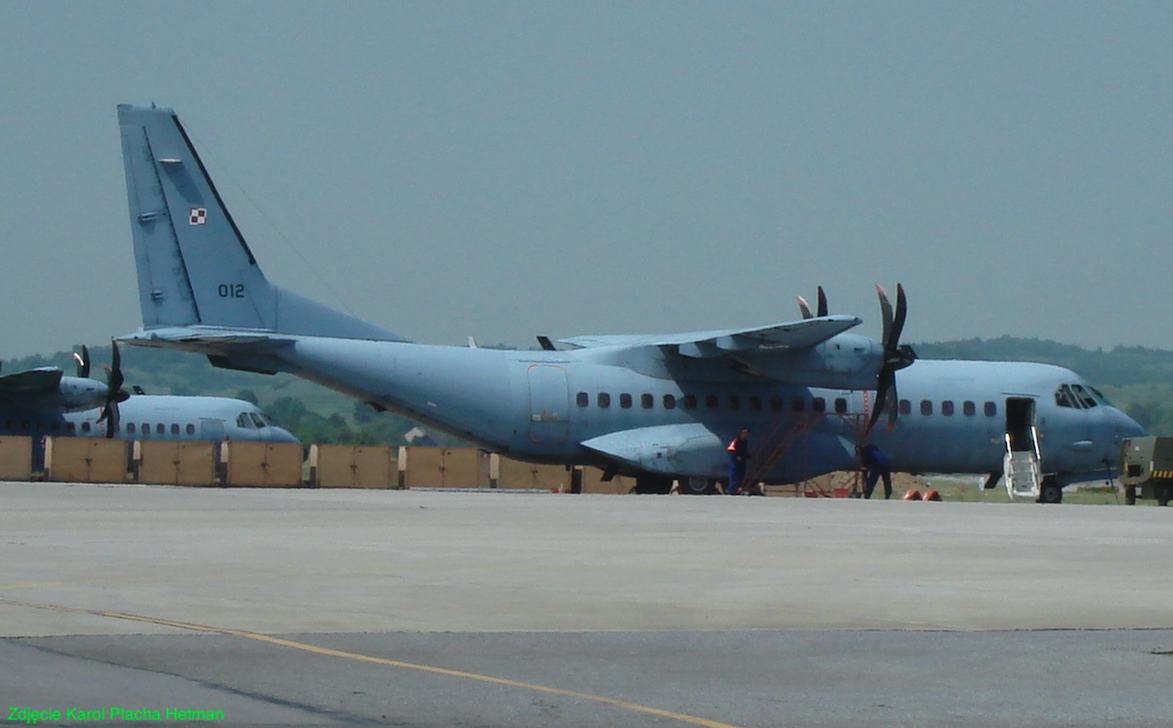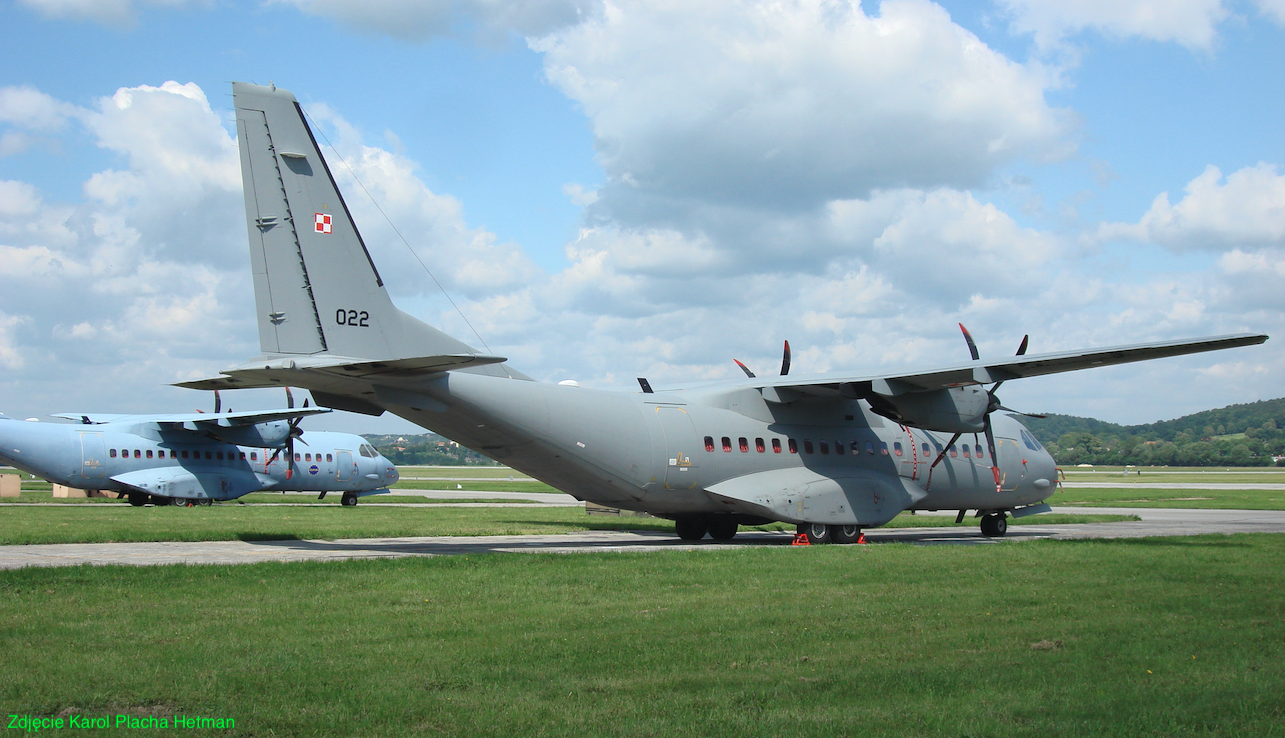Kraków 2009-12-22
13th Transport Aviation Squadron "Krakowska" in Balice.
13 ELTr was patronized by Lieutenant Colonel Stanisław Skarżyński.
History of the 13th Transport Aviation Squadron.
In 1999, the Republic of Poland was admitted to NATO membership. This was an important event because we returned to the group of free nations with a clearly defined military policy. New commitments and new challenges. This accession had a particularly strong impact on the organization and structures of the military.
After many years of service, the 13th Transport Aviation Regiment was disbanded on December 31, 2000, pursuant to the Order of the Minister of National Defense No. PF 24 of October 3, 2000, and on January 1, 2001, the 13th Transport Aviation Squadron and the 8th . Air Base. The 13th ELTr took the honorable name of pilot lieutenant colonel Stanisław Jakub Skarżyński.
13 ELTr was still the only typical transport unit of the Air Force and Air Defense. Major Sławomir Żakowski became the commander of the 13th ELTr, Major Ryszard Sarnacki became the head of training, and Major Edward Korchowiec became the head of the Engineering and Aviation Service. The tasks of the 13th ELTr included securing maneuvers of all types of armed forces, landing training of airborne troops, air cavalry, parachute training, landing landings, evacuation of the wounded and air transport of weapons and materials.
The main flying equipment was still 10 Antonov An-26 medium transport aircraft, which were supplemented by several PZL An-2 light aircraft. In addition to transport aircraft, the Squadron had PZL Mi-2 helicopters in stock, which were used to secure tasks in the rescue system.
The first new transport planes were PZL Mielec M-28 Bryza planes. In March 2002, the first two such aircraft were accepted into the Squadron’s inventory. They were used extensively on domestic and international flights. One of the PZL Mielec M-28 Bryza aircraft took part in the Royal International Air Tattoo show in Fairford, Great Britain, in July 2002.
In 2002, the first Mil Mi-8 RL helicopter was adopted as a security measure.
2003.
C-295 M aircraft became a new quality in the 13th ELTr and successfully replaced the aging An-26 aircraft.
The first of the C-295 M nb 011 aircraft ordered by Poland was taken over by the Polish Army in Spain on August 1, 2003, and intensive training of Polish crews in the air by Spanish instructors lasted for two weeks. The first four pilots trained for the new type flew the C-295 in Spain for 36 hours each. The training of subsequent crews and technicians was continued in the country. This plane (nb 011) was brought to Poland to Balice from Seville on August 15, 2003, on the Polish Army Day. The crew commander was pilot major Grzegorz Czerpak. The blue-gray transport with a checkered pattern and the number 011 on the fin is the first to enter the equipment of the 13th Transport Aviation Squadron.
The second C-295 M nb 012 aircraft was to be taken over by the Polish side on August 18, 2003, but due to the failure of one of the Pratt-Whitney Canada PW 127 G engines, with a power of 2 x 1,944 kW (2 x 2,645 HP) , the handover procedure was delayed until early September 2003. Finally, the plane arrived in Krakow on September 8, 2003. The next three aircraft were planned to be delivered to Kraków in mid-2004, and the last three aircraft in 2005. Until the end of 2003, the aircraft were used intensively for further training of flying crews and ground staff.
The new aircraft have a maximum take-off weight of over 23,000 kg, with a maximum payload weight of 9 tons (An-26 – over 6 tons). The hold holds up to 71 soldiers and equipment. The cargo cabin is 12.7 m long, 2.36 m wide and 1.9 m high (An-26 11.5 m, 2.4 m and 1.9 m respectively). It was generally said (in 2003) that the C-295 was twice as good as the An-26, because it flies twice as far and carries twice as much cargo.
The range of the C-295 aircraft with a payload of 8 tons is approximately 2,200 km, which allows it to fly to most airports in Europe. For example, from Krakow to Baghdad (Iraq) it is approximately 2,800 km in a straight line. According to the manufacturer’s data, the maximum range is over 5,600 km, which at a cruising speed of 480 km/h means over 10 hours of flight (for example, from Krakow to Delhi in India is about 5,300 km). A new feature on the transport aircraft of the Air Force and Air Defense (currently 2009, Air Force) are defense systems – C-295 M are equipped with flare and trap launchers against anti-aircraft missiles. C-295 M power unit – Pratt&Whitney Canada PW127G (used, among others, in ATR 72 aircraft). The engines are driven by a six-blade Hamilton Standard 568F-5 propeller. C-295 M aircraft are adapted to use grass runways.
Out of journalistic obligation, we will write that the nb 011 plane is the second C-295 M flying with the checkerboard. The first one was, in fact, a Spanish plane number XT.21-02, which had a checkerboard pattern glued to the fuselage during the show in Radom in 2002 (on the wings and stabilizer).
On July 28, 2005, the Krakow 13th ELTr received the last of the first series of eight ordered EDAS CASA C-295 M transport aircraft. On this occasion, a ceremony was held with the aircraft handed over to the unit by the Minister of National Defense. This plane arrived in Balice on July 23, 2005.
The invoice for 8 aircraft was repaid in eight equal installments, paid over 4 years. Thanks to the stable financing of the Ministry of National Defense by the budget of the Republic of Poland, the repayment was regular and even slightly ahead of time. This resulted in faster delivery of aircraft to Poland. The favorable exchange rate of the Polish currency allowed us to save several million dollars. They were used to retrofit aircraft. The relevant annex was signed on November 16, 2004. The main attention was paid to the elements of self-defense. Mainly the Indra ALR-300(V2)R radiation warning system. EDAS AN/AAR-60 MILD (Missile Launch Detection System) warning system against launched anti-aircraft missiles. Four sets of titanium-composite cabin armor were purchased. Medical evacuation kits. Medical kits (reanimation and life support). Quick loading and unloading systems in flight. We must add that it was a period when it was practiced to install these devices only on certain machines. All Polish C-295 M aircraft are equipped with a Raytheon APX-100 IFF system transponder. Eight BAE Systems AN/ALE-47 thermal and radar trap launchers each. The first aircraft with such additional equipment was built during a warranty inspection in Spain.
C-295 M aircraft received uniform light blue-gray painting and side numbers from 011 to 018 (in several cases they correspond to factory numbers).
In view of the needs of the Air Force, involved in the implementation of tasks related to the presence of Polish Military Contingents outside the country (mainly Iraq, Afghanistan and the Balkans), Poland decided in December 2006 to increase the number of C-295 M aircraft. On December 22, 2006 year, an appropriate annex was signed. The aircraft, which received nb 019 and 020, arrived at the 13th ELTr in August and September 2007. Since then, the Krakow squadron has operated 10 C-295 M aircraft.
In October 2007, another annex to the original contract was signed, which concerned the purchase of two aircraft along with a package of additional equipment and spare parts. The situation was facilitated by the favorable exchange rate of the Polish currency. But it doesn’t end there. Taking advantage of the opportunity to extend the contract concluded with the Spanish company in August 2001, annexes were signed, which increased the scope of the contract to include further elements of the aircraft’s equipment. The increase in the subject of the supply agreement resulted in the signing of the first annex to the offset agreement on February 19, 2007, increasing its value by USD 94.32 million. The annex involved another 12 offset obligations. Four of them concerned the company ETC-PZL Aerospace Industries Sp. z o. o., known, among others, for the production of devices for training catapulting procedures, used at the Military Institute of Aviation Medicine, the "Eagle School" in Dęblin and the 31st Air Base in Krzesiny (device intended for training F-16 pilots).
A few months later, on October 30, 2007, the original contract for the purchase of C-295 M aircraft was once again extended: Undersecretary of State at the Ministry of National Defense, Bartłomiej Grabski, signed the document – Annex No. 13 – regarding the purchase of two more machines along with a large package of additional equipment and spare parts.
After several years of intensive use of CASA C-295 M aircraft by the Air Force, they were given a positive assessment – they successfully enabled the implementation of tasks related to supplying Polish and allied troops engaged in international missions in various parts of the world. Therefore, it was decided to increase their number to 12. The meeting during which the annex was signed was attended by the President of EADS-PZL Jose Leal, the Ambassador of Spain in Poland Rafael Mendivil, the Military Attache of the Embassy of Spain in Poland Col. Carlos Hernando Guttieres, Aleksandra Dyka from the Department of Offset Programs Ministry of Economy, the commander of the Air Force, pilot lieutenant general Andrzej Błasik, and the director of the Armed Forces Supply Department, brigadier general Sławomir Szczepaniak. The annex also assumed the training of further Polish crews. However, for deliveries to be made, it was necessary to sign Annex No. 2 to the original offset agreement between the State Treasury and the manufacturer, the EADS-CASA concern, within 60 days. Such a document on December 21, 2007 was signed by the Minister of Economy, Deputy Prime Minister Waldemar Pawlak on the State Treasury’s side, and by Gabriel Alonso, Vice-President for Offset on the manufacturer’s side. The annex increased the value of the offset agreement by USD 78.70 million and its value amounted to USD 385.58 million. In accordance with the provisions of Annex No. 13, two CASA C-295 M aircraft appeared in Poland in the fall of 2008 and they were the tenth and eleventh aircraft of this type in the Polish Air Force.
On January 23, 2008, the C-295 M plane with the tail number Nb 019 crashed near the military airport in Mirosławiec.
Operation of the C-295 M.
One of the main tasks that was immediately assigned to the fleet of Spanish transporters was to maintain shuttle communication between the Republic of Poland and the Polish Military Contingent stationed in Iraq. Let us recall that in August 2003, 2,500 soldiers were sent to the area of the Iraqi stabilization mission – the Polish Transport Aviation faced a big challenge in securing the contingent.
What was such a flight like? To describe how dangerous these flights are, let’s just say that Polish crews fly there in bulletproof vests and with personal weapons, but without parachutes. From Balice the plane flies to Strachowice near Wrocław. The local airport, i.e. the 3rd Air Base, is part of the 3rd Transport Aviation Brigade. The airport has the best logistics facilities to handle foreign flights. The second reason is the proximity of military units that have their soldiers on missions. After loading and customs clearance, the Polish transport flies over Ukraine and Moldova, or the Balkans. Then on the Black Sea. The plane lands in Baku, the capital of Azerbaijan. There’s a stopover here. After taking off from Baku, the flight leads over the Caspian Sea and Turkmenistan. Next are the Mountains of Afghanistan and the airports in Kabul or Bagram. Sometimes planes fly to Sharan, where the Polish Battle Group is located. There is a primitive airport there. Built on a rocky plane, 2,500 m above sea level, RWY is 1,400 m high, but only 18 m wide, while the wingspan of the C-295 is almost 26 m. All flights to Afghanistan were made during the day. There was a ban on flights after dark.
Flights to Iraq were also dangerous. If the plane was carrying more than 5,000 kg of cargo, the stopover was in Turkey, Ankara or Trabzon airport. Polish C-295 M planes also performed other record-breaking flights. In January 2007, planes transported illegal immigrants to Vietnam via Afghanistan and India. However, the praise for the plane did not change the fact that it is a relatively slow, loud and smaller transport plane, and the Republic of Poland uses it as a strategic plane. We have even greater appreciation for the pilots of these machines. A flight to Afghanistan can take over 13 hours. According to the procedure, the pilot is entitled to a break of at least 24 hours, which was not always possible.
In 2005, thanks to the huge demand for transport flights, C-295 M aircraft’s annual flights significantly exceeded the average in the Air Force. Record-holding pilots achieved 400 hours of flight time a year. At that time, the 13th ELTr had 10 An-26 aircraft, several 18-seat M-28 Bryza, several An-2, a Mi-8 RL rescue helicopter and several Mi-2 helicopters. In 2006, the C-295 M flight time exceeded 6,300 hours. Periodic inspections of aircraft are performed in Balice.
It is impossible not to mention the planned use of the C-295 M for the landing of units of the 6th Air Assault Brigade. Plans to adapt the planes to the parachute equipment used in Poland were not fully implemented for a simple reason – finances. By decision of the commanders, smaller PZL M-28 planes began to be used for the landing of parachute jumpers.
Until November 2007, the 13th ELTr was the only transport unit. In November 2007, the 14th ELTr was established, stationed at the airport in Powidz. All C-295 M were still operated in Balice. There is no indication that the number of planes will decrease. The raid is divided into training and operational. Distribution flights are divided into service flights, operational flights and own flights. So far, there are no service flights on the C-295 M. Flights for personal use are minimal. Therefore, Polish C-295 M aircraft mainly perform training and operational flights. Training flights constitute approximately 30% of the total raid. This is relatively a lot. This is due to the lack of simulators that CASA has not yet developed and we have to conduct all pilot training on Polish aircraft. We do not have another aircraft that would be similar in terms of piloting to the C-295 M. The use of aircraft is so intensive that 100% of the planned flights were already carried out in October. The plan assumed 3,500 hours in the air. At that time, the An-26 aircraft stayed in the air for only 750 hours.
Aircraft records in the 13th ELTr as of September 30, 2007.
CASA C-295 M Nb 011, 012, 013, 014, 015, 016, 017, 018, 019, 020. Antonow An-26 Nb 1403, 1406, 1509, 1602, 1603. PZL M-28 Nb 0208, 0209, 0210, 0211, 0212, 0213, 0214, 0215, 0216, 0217. PZL An-2 Nb 0852, 7447 (Wiedenczyk).
CASA C-295 M disaster, 2008 year.
On January 23, 2008, one of the planes (nb 019) crashed near Mirosławiec. 20 Air Force soldiers died and the machine was destroyed.
On January 23, 2008, around 7 p.m., during the approach to landing at the military airport in Mirosławiec, a Polish Armed Forces transport aircraft type CASA C-295 M nb 019, belonging to the 13th Transport Aviation Squadron stationed in Balice, crashed. The plane was flying along the planned route; Okęcie, Powidz, Krzesiny, Mirosławiec, Świdwin, Balice. There were 16 passengers and 4 crew members on board.
On January 23, 2008, the 50th Flight Safety Conference was held at the Air Force Command in Warsaw. The conference was attended by management staff. After the conference, some of its participants boarded the transport plane. At 4:51 p.m., 4 crew members and 41 passengers took off from Okęcie.
The aircraft with side number 019 was manufactured in 2007, was delivered to Poland on August 1, 2007, and a month later it was incorporated into the Air Force. The plane has achieved 393 hours of flight time, so it should undergo its first periodic maintenance after 300 hours of flight. This service was performed on November 29, 2007. The plane was new and modern. Capable of flying "in all weather conditions" during the day and at night.
The flight went smoothly. Landing (17:35) in Powidz. 10 soldiers disembarked here and took off (17:51) to Krzesiny. Landing (18;11) and 15 soldiers disembarked. Start from Krzesiny (18:24) to Mirosławiec, no comments. Ceiling 4,900 m and speed 400 km/h. During the landing approach, the crew was forced to go around. At approximately 7:01 p.m., during the second attempt to land, the plane crashed approximately 1,300 m before the RWY threshold. There was a fire. A rescue operation was initiated immediately.
Weather situation in Krzesiny (18:30); cloud cover 7/4, cloud base 390 m, visibility 5 km, fog, wind 180/2, air temperature 0.8 degrees C, humidity 94%, pressure 1029.4. In Mirosławiec (7:00 p.m.); cloud cover 8/7, cloud base 90 m, visibility 3 km, wind mist 190/1, air temperature 0.7 degrees C, humidity 97%, pressure 1027.0.
After the tragic C-295 M crash, the commander of the Air Force issued a ban on flights on this type of aircraft until further notice. However, based on the letter of the chairman of the State Aviation Accident Investigation Commission on January 31, 2008, two planes based in Afghanistan and Lebanon were allowed to fly to the country (they had previously been subject to technical efficiency reviews), and on February 1, 2008, all C-295 planes M returned to service.
Fallen passengers:
Brigade General Andrzej Andrzejewski, commander of the 1st Tactical Aviation Brigade in Świdwin. Lieutenant Colonel Zdzisław Cieślik, head of training of the 1st Tactical Aviation Brigade in Świdwin. Major Robert Maj from the aviation training section of the 1st Tactical Aviation Brigade in Świdwin. Major Mirosław Wilczyński, head of the aviation technology section of the 1st Tactical Aviation Brigade in Świdwin. Colonel Jerzy Piłat, commander of the 12th Air Base in Mirosławiec. Lieutenant Colonel Dariusz Pawlak, head of the aviation technology section of the 12th Air Base in Mirosławiec. Major Grzegorz Jułga, deputy commander of the 8th Tactical Aviation Squadron in Mirosławiec. Captain Paweł Zdunek, commander of the 8th Tactical Aviation Squadron in Mirosławiec. Captain Karol Szmigiel, technical commander of the 8th Tactical Aviation Squadron in Mirosławiec. Colonel Dariusz Maciąg, commander of the 21st Air Base in Świdwin. Major Piotr Firlinger, head of the aviation technology section of the 21st Air Base in Świdwin. Lieutenant Colonel Zbigniew Książek, deputy commander of the 22nd Air Base in Malbork. Lieutenant Colonel Wojciech Maniewski, commander of the 40th Tactical Aviation Squadron in Świdwin. Captain Leszek Ziemski, flight safety instructor of the 40th Tactical Aviation Squadron in Świdwin. Captain Grzegorz Stepaniuk, head of aviation technology of the 40th Tactical Aviation Squadron in Świdwin. Major Krzysztof Smołucha from the Air Force Command.
Killed crew:
Major Jarosław Haładus, chief of aviation technology from the 13th Transport Aviation Squadron. Lieutenant Robert Kuźma, senior instructor from the 13th Transport Aviation Squadron. Lieutenant Michał Smyczyński, senior pilot from the 13th Transport Aviation Squadron. Sergeant Janusz Adamczyk, flight technician from the 13th Transport Aviation Squadron.
The last C-295 M delivered to Poland. 2008.
On December 19, 2008, the last ordered CASA C-295 M nb 022 landed at the Balice airport. The plane arrived in Poland three days earlier. The plane belongs to the PO 02 production series and has more extensive equipment than previous models. At that moment, the 13th ELTr had 11 machines of this type in stock. The ceremony was attended by Minister of National Defense Bogdan Klich. Minister Bogdan Klich praised the plane, noting, among other things, on its usefulness in carrying out transport tasks of Polish military contingents outside the country. The minister recalled that F-16 Jastrząb fighters were delivered two weeks earlier.
There will be no further CASA C-295 M transport aircraft in the Krakow squadron. As in the case of the MRTT transport and refueling aircraft, the Ministry of National Defense decided not to purchase them, although earlier it was considered to place an order for four or five more machines in order to have 16 C-295 M aircraft. Let me remind you that we are obliged to have this type of aircraft in accordance with the accession agreement. to NATO.
C-295 M aircraft in Poland represent three versions: PO 01, PO 02 and PO 02 SB. There are six planes in the PO 01 version (013-018), three in the PO 02 version (020-022) and two in the PO 02 SB (Service Bulletin) version (011, 012). The plane was lost in a plane crash in January 2008. (019) belonged to the PO 02 version. This is the current state, eight planes in the PO 01 version and four (the newest) in the PO 02 version were purchased. Currently (2008) one of the PO 01 planes is being modernized in Spain, it is waiting also other machines of this version. Modernization to the PO 02 SB version includes selected equipment elements, excluding those that fulfill their tasks. The scope of additional equipment results, among other things, from experience in operating the aircraft and the tasks performed.
Organizational changes in Polish Transport Aviation. 2009.
As of January 1, 2009, the 3rd Transport Aviation Brigade, which included the 13th ELTr and 14th ELTr, by the decision of the Air Force Commander, Order No. PF 198 of August 26, 2008, was transformed into the 3rd Transport Aviation Wing. The change was dictated by the constantly growing importance of transport aviation in the Air Force of the Republic of Poland.
Photo description: C-295 M nb 022 – the twelfth aircraft of this type delivered to Poland. In the depth of nb 013. Please see the different color of the last machines.
Commanders of the 13th ELTr;
Lieutenant Colonel, certified pilot Sławomir Żakowski, January 1, 2001. – September 30, 2005 Lieutenant Colonel, certified pilot Leszek Leśniak, October 1, 2005. – January 1, 2009.
Commanders of the 8th Blot;
Lieutenant Colonel certified pilot Tomasz Drewniak 1/01/2001 – June 7, 2004 Colonel M.Eng. Krzysztof Krasnodębski 8/06/2004 – August 30, 2006 Lieutenant Colonel, certified pilot Sławomir Żakowski, August 31, 2006. – February 26, 2008 Colonel M.Eng. Mirosław Jemielniak 27/02/2008 – August 1, 2010 Col. Dipl. pil. Jacek Łazarczyk 1/08/2010 – May 12, 2014 Col. pil. Krzysztof Cur 12/05/2014 – 10/06/2016 Lt. Col. M. Eng. Marek Majocha 1/06/2016 – October 10, 2016 Col. Dr. Eng. pil. Krzysztof Szymaniec 10/10/2016 – September 29, 2017 Vol. after. Col. Grzegorz Kot 30/09/2017 – October 29, 2017 Col. pil. MSc. Paweł Bigos 30/10/2017 – …
Written by Karol Placha Hetman

